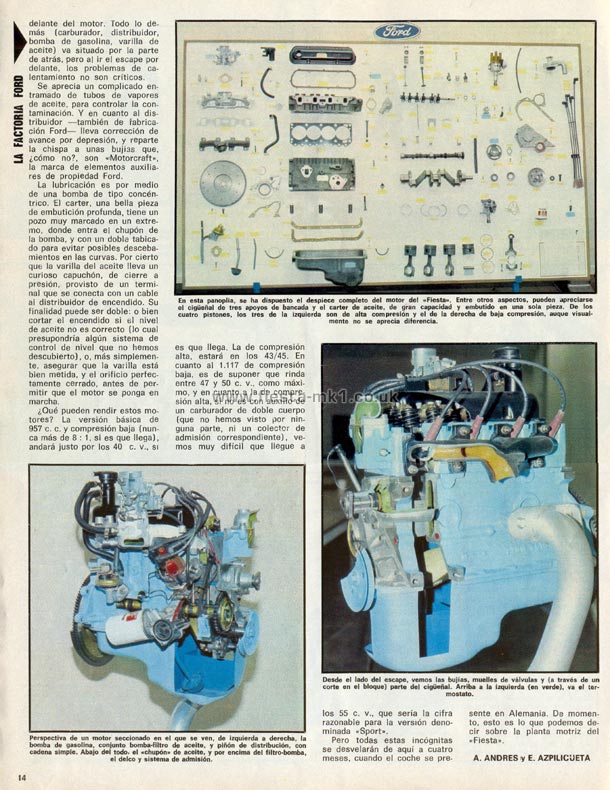English Translation and Original Text Below
.....front of the engine. Everything Else (carburetor, distributor, fuel pump, oil dipstick) is located on the back, but to go ahead leakage, overheating problems are not critical poop.
It shows a complicated network of steam pipes of oil pollution control. And as for the manufacturing distributor Ford also carries forward correction for depression, and distributes the spark plugs about that, why not?, Are "Motorcraft", the brand owned subsidiary of Ford items.
Lubrication is via a concentric pump. £ 1 sump, a beautiful piece of deep drawing, has a very well marked on one end where the nipple enters the pump, and a dual riser-do to avoid desceba-ments in the corners. Indeed, the dipstick is a curious cap, closure pressure, provided with a terminal that connects to a cable to the ignition distributor. Its purpose may be twofold: either cut the ignition if the oil level is not correct (which presuppose a level control system that we have not discovered), or, more simply, to ensure that the rod is well stuck, and the hole tightly closed before allowing the engine to take off.
What can they pay these engines? The basic version of 957 c. c. and low compression (never more than 8: 1, if ever), walking just 40 c. v., if ever. The high compression, will be on 43/45. As for the 1117 low compression, presumably to yield between 47 and 50 c. v., at most, and as for the high compression, if not in terms of a dual carburetor body (we have not seen anywhere, nor a corresponding intake manifold), we find very difficult to reach the 55 C. v., which would be a reasonable figure for the version called "Sport".
But all these unknowns will be unveiled within the next four months, when the car is present in Germany. For now, this is what we say about the power plant of the "Fiesta".
A. ANDRÉS and E. AZPILICUETA
Captions -
Top - In this mix, provision has been completely cutting engine! "Fiesta". Among other things, the crankshaft can be seen three bench supports and the oil pan, high-capacity, embedded in one piece. Of the four pistons, three on the left are high compression, the right-low compression, Auque difference is not apparent visually.
Bottom-Left - Sectioned perspective of an engine which are, from left to right, pump, pump set oil-íütro and distribution gear, with single chain. Bottom, the "pacifier" of oil, and above the filter-pump, delco and intake system.
Bottom-Right - Since the exhaust side, we see the spark plugs, valve springs and (through a cut in the block) of the crankshaft. Top left (green), is the thermostat.
Original Text
.....delante del motor. Todo lo demás (carburador, distribuidor, bomba de gasolina, varilla de aceite) va situado por la parte de atrás, pero al ir el escape por delante, los problemas de caca lentamiento no son críticos.
Se aprecia un complicado entramado de tubos de vapores de aceite, para controlar la contaminación. Y en cuanto al distribuidor -también de fabricación Ford- lleva corrección de avance por depresión, y reparte la chispa a unas bujías que, ¿cómo no?, son "Motorcraft", la marca de elementos auxiliares de propiedad Ford.
La lubricación es por medio de una bomba de tipo concéntrico. £1 cárter, una bella pieza de embutición profunda, tiene un pozo muy marcado en un extremo, donde entra el chupón de la bomba, y con un doble tabica-do para evitar posibles desceba-mientos en las curvas. Por cierto que la varilla del aceite lleva un curioso capuchón, de cierre a presión, provisto de un terminal que se conecta con un cable al distribuidor de encendido. Su finalidad puede ser doble: o bien cortar el encendido si el nivel de aceite no es correcto (lo cual presupondría algún sistema de control de nivel que no hemos descubierto), o, más simplemente, asegurar que la varilla está bien metida, y el orificio perfectamente cerrado, antes de permitir que el motor se ponga en marcha.
¿Qué pueden rendir estos motores? La versión básica de 957 c. c. y compresión baja (nunca más de 8 : 1, si es que llega), andará justo por los 40 c. v., si es que llega. La de compresión alta, estará en los 43/45. En cuanto al 1.117 de compresión baja, es de suponer que rinda entre 47 y 50 c. v., como máximo, y en cuanto a la de compresión alta, si no es con auxilio de un carburador de doble cuerpo (que no hemos visto por ninguna parte, ni un colector de admisión correspondiente), vemos muy difícil que llegue a los 55 c. v., que sería la cifra razonable para la versión denominada "Sport".
Pero todas estas incógnitas se desvelarán de aquí a cuatro meses, cuando el coche se presente en Alemania. De momento, esto es lo que podemos decir sobre la planta motriz del "Fiesta".
A. ANDRÉS y E. AZPILICUETA
Captions -
Top - En esta panoplia, se ha dispuesto el despiece completo del motor de! "Fiesta". Entre otros aspectos, pueden apreciarse el cigüeñal de tres apoyos de bancada y el cárter de aceite, de gran capacidad y embutido en una sola pieza. De los cuatro pistones, los tres de la izquierda son de alta compresión y el de la derecha de baja compresión, auque visualmente no se aprecia diferencia.
Bottom-Left - Perspectiva de un motor seccionado en el que se ven, de izquierda a derecha, la bomba de gasolina, conjunto bomba-íütro de aceite, y piñón de distribución, con cadena simple. Abajo del todo, el "chupón" de aceite, y por encima del filtro-bomba, el delco y sistema de admisión.
Bottom-Right - Desde el lado del escape, vemos las bujias, muelles de válvulas y (a través de un corte en el bloque) parte del cigüeñal. Arriba a la izquierda (en verde), va el termostato.
|








